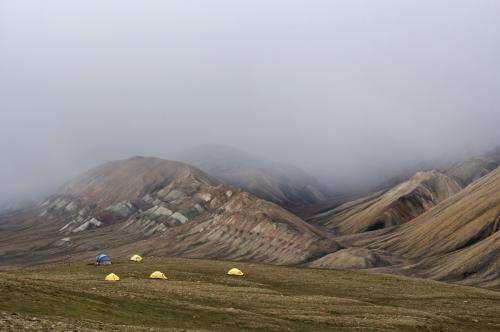This is an illustration of the High Arctic camel on Ellesmere Island during the Pliocene warm period, about three-and-a-half million years ago. The camels lived in a boreal-type forest. The habitat includes larch trees and the depiction is based on records of plant fossils found at nearby fossil deposits. Credit: Julius T. Csotonyi
(Phys.org) —A Canadian research team, helped by scientists at The University of Manchester, has discovered the first evidence of an extinct giant camel in the High Arctic. The three-and-a-half million year old fossil was identified using collagen fingerprinting from bone fragments unearthed on Ellsmere Island. It's the furthest North a camel has ever been found.
The fossils were collected over three summers in 2006, 2008 and 2010 by Dr. Natalia Rybczynski, a vertebrate paleontologist with the Canadian Museum of Nature. Some important physical characteristics suggested the fossil fragments were part of a large tibia, the main lower-leg bone in mammals. Digital files of each of the 30 bone fragments were produced using a 3D laser scanner, allowing for the pieces to be assembled and aligned.
However, it was still unclear which species the bone came from. So the researchers enlisted the help of Dr. Mike Buckley from the Manchester Institute of Biotechnology. He used the pioneering new technique called "collagen fingerprinting" to identify the animal from the bone fragments.
He did this by extracting minute amounts of collagen, the dominant protein found in bone, from the fossils. Using chemical markers for the peptides that make up the collagen, a collagen profile for the fossil bones was developed. Dr. Buckley then compared the profile to 37 modern mammal species, as well as that of a fossil camel found in the Yukon.
He found that the collagen profile for the High Arctic camel was almost an identical match to the modern day Dromedary as well as the Ice-Age Yukon giant camel. The collagen information, combined with the anatomical data, demonstrated that the bone fragments belonged to a giant camel as the bone is roughly 30% larger than the same bone in a living camel species.
Dr. Rybczynski says it's an important discovery: "These bones represent the first evidence of camels living in the High Arctic region. It extends the previous range of camels in North America northward by about 1,200 km, and suggests that the lineage that gave rise to modern camels may have been originally adapted to living in an Arctic forest environment."
Dr. Buckley adds: "This is the first time that collagen has been extracted and used to identify a species from such ancient bone fragments. The fact the protein was able to survive for three and a half million years is due to the frozen nature of the Arctic. This has been an exciting project to work on and unlocks the huge potential collagen fingerprinting has to better identify extinct species from our preciously finite supply of fossil material."
This is Camp 2 at the Fyles Leaf Bed Site on Ellesmere Island, near Strathcona Fiord, during 2008 field season. This is the area where the fossil remains of the High Arctic camel were discovered over three field seasons. Credit: Martin Lipman, Canadian Museum of Nature
Dr. Roy Wogelius from The University of Manchester's School of Earth, Atmospheric & Environmental Sciences analysed the mineral content of the bones. His findings suggest that mineralization worked along with cold temperatures to help preserve the proteins in the bones: "This specimen is spectacular, and provides important clues about how such exceptional preservation may occur" said Dr. Wogelius.
The camel bone fragments were collected from a steep slope at the Fyles Leaf Bed site, a sandy deposit near Strathcona Fiord on Ellesmere Island. Other fossil finds at the site suggest the High Arctic camel was living in a boreal-type of forest environment, during a global warm phase on the planet.
Dr. Rybczynski says the discovery sheds new light on modern camels: "We now have a new fossil record to better understand camel evolution, since our research shows that the Paracamelus lineage inhabited northern North America for millions of years, and the simplest explanation for this pattern would be that Paracamelus originated there. So perhaps some specializations seen in modern camels, such as their wide flat feet, large eyes and humps for fat may be adaptations derived from living in a polar environment."
The identification of the High Arctic camel is described in the March 5 edition of the online journal Nature Communications.
Journal information: Nature Communications
Provided by University of Manchester
























